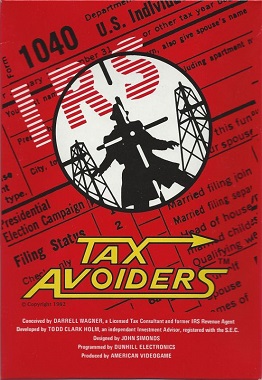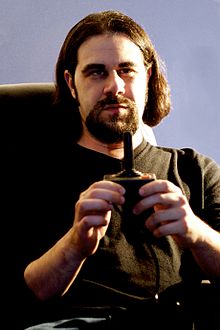
Tax Avoiders is a single-player video game for the Atari 2600 released in 1982. It was conceived by Darrell Wagner at Dunhill Electronics; he was billed on the packaging as a "Licensed Tax Consultant and former IRS Revenue Agent". The game was developed by Todd Clark Holm, "an independant [sic] investment advisor, registered with the S.E.C." The game was designed by John Simonds and published by American Videogame.
Gonzalo Frasca is a game designer and academic researcher focusing on serious and political videogames. His blog, Ludology.org, was cited by NBC News as a popular designation for academic researchers studying video games. For many years, Frasca also co-published Watercoolergames with Ian Bogost, a blog about serious games.

Eric Zimmerman is an American game designer and the co-founder and CEO of Gamelab, a computer game development company based in Manhattan. GameLab is known for the game Diner Dash. Each year Zimmerman hosts the Game Design Challenge at the Game Developers Conference. He is also the co-author of four books including Rules of Play with Katie Salen, which was published in November 2004. Eric Zimmerman has written at least 24 essays and whitepapers since 1996, mostly pertaining to game development from an academic standpoint. He's currently a founding faculty at the NYU Game Center.

Air-Sea Battle is a fixed shooter developed and published by Atari, Inc. for the Atari VCS. Air-Sea Battle is partially based on the 1975 Atari arcade video game Anti-Aircraft where each player uses a ground-based gun to shoot passing aircraft. The cartridge adds other variants, such as planes dropping bombs on ships and a carnival-themed shooting gallery.

Pepsi Invaders is a non-commercially released 1983 fixed shooter video game developed by Atari, Inc. for the Atari 2600. It was commissioned by The Coca-Cola Company to be handed out to salespeople at their 1983 sales convention. A reskin of the system's version of Space Invaders, the player shoots down a flying formation of letters spelling "PEPSI", Coca-Cola's long-time rival. Only 125 copies were distributed.

280 ZZZAP is a racing arcade video game designed by Jamie Fenton for Dave Nutting Associates. Based on Nissan's Datsun 280Z, it is one of the earliest games with authorized branding.

Video Olympics is a video game programmed by Joe Decuir for the Atari 2600. It is one of the nine 2600 launch titles Atari, Inc. published when the 2600 system was released in September 1977. The cartridge is a collection of games from Atari's popular arcade Pong series. A similar collection in arcade machine form called Tournament Table was published by Atari in 1978.

Pac-Man is a 1982 maze video game developed and published by Atari, Inc. under official license by Namco, and an adaptation of the 1980 hit arcade game of the same name. The player controls the title character, who attempts to consume all of the wafers in a maze while avoiding four ghosts that pursue him. Eating flashing wafers at the corners of the screen causes the ghosts to temporarily turn blue and flee, allowing Pac-Man to eat them for bonus points. Once eaten, a ghost is reduced to a pair of eyes, which return to the center of the maze to be restored.

Nick Montfort is a poet and professor of digital media at MIT, where he directs a lab called The Trope Tank. He also holds a part-time position at the University of Bergen where he leads a node on computational narrative systems at the Center for Digital Narrative. Among his publications are seven books of computer-generated literature and six books from the MIT Press, several of which are collaborations. His work also includes digital projects, many of them in the form of short programs. He lives in New York City.

Shark Jaws is a single-player arcade video game by Atari, Inc. under the name of Horror Games, originally released in 1975. An unlicensed tie-in to the movie Jaws, and believed to be the first commercially released movie tie-in, it was created to be a game about sharks eating people. Atari head Nolan Bushnell originally tried to license the Jaws name, but was unable to secure a license from Universal Pictures. Deciding to go ahead with the game anyway, it was retitled Shark JAWS, with the word Shark in tiny print and JAWS in large all caps print to create greater prominence. Bushnell created a second hidden subsidiary corporation, Horror Games—the previous being Kee Games—to help isolate Atari from a possible lawsuit. According to Bushnell, the game was successful enough to sell approximately two thousand units.
Newsgames are a genre of video games that attempt to apply journalistic principles to their gameplay. Newsgames can provide context to complex situations which might be hard to explain without experiencing the situation firsthand. According to newsgame developers Ian Bogost, Simon Ferrari and Bobby Schweizer, newsgames are a "body of work produced at the intersection of video games and journalism." Journalists use newsgames to expand on stories so the audience can learn more about the information in an immersive way.

The first hobbyist-developed game for the Atari 2600 video game console was written in 1995, and more than 100 have been released since then. The majority of games are unlicensed clones of games for other platforms, and there are some also original games and ROM hacks. With only 128 bytes of RAM, no frame buffer, and the code and visuals closely intertwined, the 2600 is a difficult machine to program. and many games were written for the technical challenge. Emulators, programming tools, and documentation are available.

M Network was a video game division of Mattel that, in the 1980s, produced games in cartridge format for the Atari 2600 video game system.

Tooth Protectors is a rare video game for the Atari 2600 video game console. It was released exclusively via mail order in 1983 by American pharmaceutical and consumer goods manufacturer Johnson & Johnson.

Bushnell's Law or Nolan's Law is an aphorism often attributed to Atari founder Nolan Bushnell, on the subject of video game design:
All the best games are easy to learn and difficult to master. They should reward the first quarter and the hundredth.
Mattie Brice is an independent video game designer, critic, educator, and industry activist. Her games and writing focus on diversity initiatives in the games industry, discussing the perspective of marginalized minority voices to publications like Paste, Kotaku, and The Border House. Her games are freeware and do not require programming to create.

Procedural rhetoric or simulation rhetoric is a rhetorical concept that explains how people learn through the authorship of rules and processes. The theory argues that games can make strong claims about how the world works—not simply through words or visuals but through the processes they embody and models they construct. The term was first coined by Ian Bogost in his 2007 book, Persuasive Games: The Expressive Power of Videogames.
Eddo Stern is a California-based artist and developer known for creating experimental video games, game art and machinima-based works. Stern was a founding member of the physical-computing based collective and artist-run space C-Level. He holds a BA in Electronic Media and Art from University of California at Santa Cruz and an MFA in Art and Integrated Media from California Institute of the Arts. A professor at University of California Los Angeles' Design Media Arts program, he is additionally the director of the UCLA Game Lab.

Balance of the Planet is a simulation video game developed by Chris Crawford. He self-published it in 1990 for Macintosh. It was ported to MS-DOS and PC-98.















